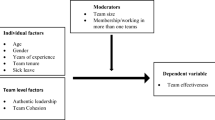Abstract
As the delivery of mental health services becomes increasingly complicated, effective utilization of human resources and improving quality of services have acquired heightened importance. This article describes the development of synergistic teams within mental health treatment settings to reach these goals. Leadership, disciplines, interdisciplinary work, functioning and process, and empowerment are also examined.
Similar content being viewed by others
References
Bendicsen, H., & Carlton, S. (1990). Clinical team building: A neglected ingredient in the therapeutic milieu.Residential Treatment for Children and Youth, 8(1), 5–21.
Bermon, S. (Ed.). (1992).Joint Commission Perspectives. 12(2).
Berwick, D. M. (1989). Continuous improvement as an ideal in health care.The New England Journal of Medicine, 5, 53.
Berwick, D. M., Godfrey, A. B., & Roessner, J. (1991).Curing health care. San Francisco: Jossey-Bass.
Burns, C., & Watson, M. (1991, April).Innovative team building in child treatment programs. Paper presented at the annual Albert E. Trieschman Conference, Boston.
Byham, W. C., & Cox, J. (1988).Zapp! The lightening of empowerment. New York: Harmony.
Cornwall, J. R., & Perlman, B. (1990).Organizational entrepreneurship. Boston: Irwin.
Cory, G. (1985).Theory and practice of group counseling. Monterey, CA: Brooks/Cole.
Freeman-Longo, R., & Ryan, G. (1990). Tort liability in the treatment of sexually abusive juveniles.Interchange-National Adolescent Perpetrators Network. October, 1–8.
Garner, H. C. (1988).Helping others through teamwork. Washington, DC: The Child Welfare League of America, Inc.
Hunt, M. (1979). Possibilities and problems of interdisciplinary teamwork. In M. Marshall, M. Preston-Shoot, & E. Wincott, (Eds.),Teamwork for and against: An appraisal of multi-disciplinary practice (pp. 26–41). Birmingham, England: British Association of Social Workers.
Ivey, A. E. (1980).Counseling and psychotherapy. Englewood Cliffs, NJ: Prentice-Hall, Inc.
Kanter, R. M. (1983).The change masters. New York: Simon & Schuster.
Walton, M. (1991).Deming management at work. New York: Perigee Books.
Wellins, R. S., Byham, W. C., & Wilson, J. M. (1991).Empowered teams. San Francisco: Jossey-Bass.
Author information
Authors and Affiliations
Additional information
The author thanks Rita Shelton for her assistance in preparing this manuscript, and Mike Watson and Jeff Cornwall for their insight and support.
Rights and permissions
About this article
Cite this article
Burns, C. Innovative team building: Synergistic human resource development. Adm Policy Ment Health 22, 39–48 (1994). https://doi.org/10.1007/BF02106566
Issue Date:
DOI: https://doi.org/10.1007/BF02106566




